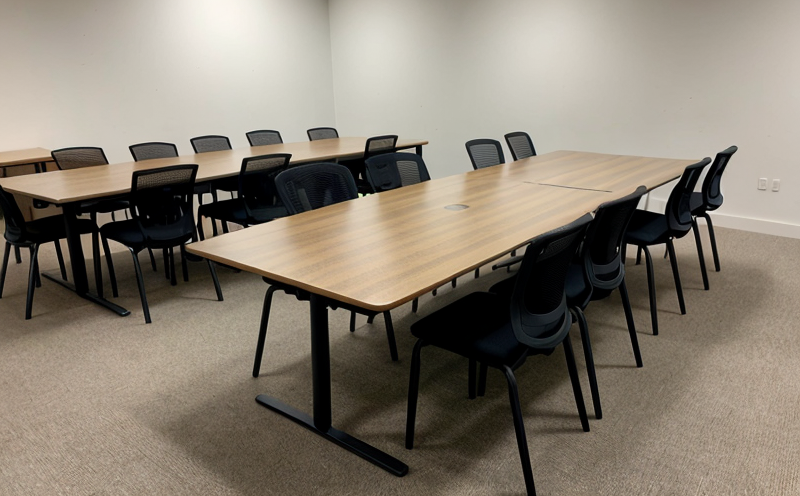ANSI BIFMA X5.5 Table Workstation Impact and Load Durability Testing
The ANSI/BIFMA X5.5 standard is a critical benchmark in furniture testing, particularly for tables and desks designed for workstations. Compliance with this standard ensures that the furniture can withstand real-world use without compromising safety or performance over time.
The table workstation impact and load durability test evaluates how well a piece of furniture will stand up to both static loads and dynamic impacts. This is essential for ensuring the longevity and reliability of office desks, meeting tables, and other similar workstations that are subject to frequent use in professional settings.
This testing ensures that the furniture can handle various scenarios such as:
- Multiple users sitting and standing
- Frequent load shifting by workers
- Accidental impacts from objects or people
- Daily use over extended periods
The test methodology involves subjecting the furniture to a series of specified loads and impacts, following strict protocols outlined in ANSI/BIFMA X5.5. This includes:
- Static load testing under various weights
- Durability tests simulating user interaction over time
- Impact resistance tests to withstand accidental drops or collisions
The test results are then compared against the specified criteria in the standard. Successful completion of these tests ensures that the furniture meets the durability and safety requirements for its intended use.
The importance of this testing cannot be overstated, especially for organizations that prioritize employee comfort and safety. By ensuring compliance with ANSI/BIFMA X5.5, companies can demonstrate their commitment to quality and reliability in their products.
Why It Matters
Compliance with the ANSI BIFMA X5.5 standard is not just a regulatory requirement; it's a reflection of best practices in furniture design and manufacturing. Here’s why this testing matters:
- Enhanced Safety: By ensuring that tables and desks can withstand the stresses they encounter, we reduce the risk of accidents or injuries.
- Prolonged Lifespan: Furniture that meets durability standards will last longer, which is beneficial for both the manufacturer and the end user.
- Better User Experience: Durable furniture provides a more comfortable and functional workspace, enhancing productivity and satisfaction.
- Compliance with Industry Standards: Meeting these standards helps companies maintain their reputation and trust among clients and partners.
Incorporating ANSI/BIFMA X5.5 testing into the manufacturing process ensures that each piece of furniture is built to last, providing long-term value for both businesses and consumers.
Applied Standards
The ANSI/BIFMA X5.5 standard provides comprehensive guidelines for testing tables and desks designed as workstations. The primary focus is on ensuring that the furniture can withstand various types of impact and load without compromising structural integrity or safety.
The standard covers several key areas, including:
- Impact resistance
- Load capacity
- Durability over time
- Stability during use
Testing is performed under controlled conditions to simulate real-world scenarios. The standard specifies the types of loads and impacts that should be tested, as well as the criteria for passing the test.
The ANSI/BIFMA X5.5 standard is widely recognized in the furniture industry as a benchmark for quality and durability. Compliance with this standard ensures that manufacturers are meeting the highest standards for their products.
Scope and Methodology
The scope of the ANSI BIFMA X5.5 Table Workstation Impact and Load Durability Testing includes evaluating the structural integrity, stability, and durability of tables and desks designed as workstations. This testing ensures that these pieces of furniture can withstand various types of stress and impact without compromising safety or performance.
The methodology for this test involves several key steps:
- Preparation: The furniture is prepared according to the specifications outlined in ANSI/BIFMA X5.5, including any necessary adjustments or modifications.
- Load Application: Static loads are applied to simulate typical use conditions, such as users sitting and standing at the workstation.
- Impact Testing: The furniture is subjected to dynamic impacts to test its resistance to accidental drops or collisions.
- Stability Checks: The stability of the furniture is evaluated under various loading scenarios to ensure it remains secure and does not tip over.
The test results are then compared against the specified criteria in ANSI/BIFMA X5.5. If the furniture passes all tests, it meets the durability and safety requirements for its intended use.
For example, a typical static load test might involve applying a weight of 200 pounds to a workstation for an extended period to simulate long-term use by multiple users. An impact test could involve dropping a heavy object from a specified height onto different parts of the furniture to assess resistance.





